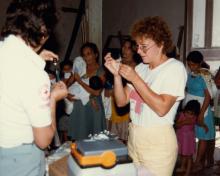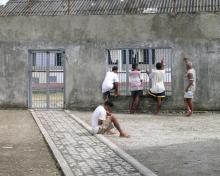Basic international humanitarian law (IHL) rules applicable to this situation:
Each party to the conflict must respect cultural property: special care must be taken in military operations to avoid damage to buildings dedicated to religion, art, science, education or charitable purposes and historic monuments unless they are military objectives. Property of great importance to the cultural heritage of every people must not be attacked unless imperatively required by military necessity.
Each party to the conflict must protect cultural property:
-
All seizure of or destruction or wilful damage done to institutions dedicated to religion, charity, education, the arts and sciences, historic monuments and works of art and science is prohibited.
-
Any form of theft, pillage or misappropriation of, and any acts of vandalism directed against, property of great importance to the cultural heritage of every people is prohibited.
The case in brief
In 2011, the North Atlantic Treaty Organization (NATO) led a military campaign, Operation Unified Protector, against the Libyan armed forces under United Nations (UN) Security Council Resolution 1973. There was concern that Libyan archaeological sites would be damaged in the fighting.
Recognizing NATO’s obligations under IHL to protect cultural property, NATO officials compiled a list of cultural sites to be protected during military operations. Cooperation with the Blue Shield and the UN Educational, Scientific and Cultural Organization (UNESCO) helped ensure the list was as comprehensive as possible [the Blue Shield is an international non-governmental organization founded in 1996 to protect endangered cultural heritage. It has adopted the distinctive blue shield emblem defined by the 1954 Hague Convention to identify cultural property to be protected in armed conflict].
After the campaign, independent assessments of conflict-related damage in Libya found that NATO had not inflicted any serious harm on cultural sites.
IHL compliance highlights
- Recognizing NATO’s responsibility to protect cultural property, target-planning officers compiled a list of sites to be protected in consultation with experts on Libyan cultural heritage.
- Having incorporated the ‘no strike list’ into its target database, NATO used precision targeting to attack military objectives without harming nearby cultural property.
- Following the campaign, international cultural protection experts assessing the state of Libya’s cultural sites found no evidence of serious damage caused by NATO air strikes.
- In 2014–2016, NATO carried out a project aimed at optimizing planning to protect cultural property during future operations.
Case prepared by Sara Ottaviani, Amy Zahra and Albany Kidd, students at Roma Tre University under the supervision of Giulio Bartolini (Associate professor of international law, Director of the Roma Tre IHL Legal Clinic) and Laura Di Gianfrancesco (PhD candidate), as well as by Jenna Corcoran and Tate Kommer, J.D. students at Emory University School of Law, under the supervision of Professor Laurie Blank, Emory University School of Law.
A. LIBYA: WORLD’S CULTURAL HERITAGE SITES AT RISK
[Source: Centro di Conservazione Archeologica (CCA) of Rome, “A review of the situation of cultural heritage in Libya after the revolution”, 19 July 2014, available at https://ccaroma.org/755-2/]
[…]
The armed conflict that started in January 2011, leading to the Gaddafi regime’s fall in October of the same year, raised concerns in the international community for the safety of archaeological sites in Libya. […]
These concerns were picked up by international organisations involved in the preservation of cultural heritage.
In June 2011 the UNESCO [United Nations Educational, Scientific and Cultural Organization] Director-General divulgated a call for the protection of two of the World Heritage Sites, the Old Town of Ghadamès and Leptis Magna.
Blue Shield, an international NGO born in 1954 as emblem of the Hague Convention for the Protection of Cultural Property in the Event of Armed Conflict, declared two official statements highlighting the threats faced by Libyan cultural heritage, the first in March and the second in June 2011.
Particularly, concerns were focused on the site of Leptis Magna: in June 2011 the Washington Post reports fears that the site could become a target for NATO bombing if found out to be a military basis of Gaddafi’s troops.
Fortunately, later in the year it seemed that Libya’s archaeological sites had survived the conflict with little damage: in an article of November 2011 Mustafa Turjman, head of research at the national department of archaeology (who recently gave an interview on this blog), stated that Tripoli’s National Museum had suffered little damage, mainly concerning symbols of Gaddafi’s regime.
In this context, a successful initiative was the establishment of a “No Strike List” by the ‘Blue Shield Committee’ and ‘The International Military Cultural Resources Work Group’ in cooperation with NATO, indicating sites that were to be kept safe from the international military intervention.
Crucial was the work of local professionals: in November 2011 an article in Culture in Development titled “Libyan World Heritage Sites Safe”, reported that the international team “was very impressed by the excellent precautionary measures of the local museum professionals and archaeologists”.
[…]
B. THE MAKING OF NO STRIKE LIST
[Source: UNESCO, Protection of Cultural Property – Military Manual , 2016, p.30, available at https://unesdoc.unesco.org/ark:/48223/pf0000246633]
[...]
The compilation of such lists should, where feasible, involve input from appropriate cultural heritage professionals and other experts, such as archaeologists, historians of art and architecture, and museum curators, as well as from appropriate non-governmental organizations, among them any relevant national committee forthe Blue Shield, and UNESCO.
The target planning process during Operation Unified Protector, in which a coalition of states conducted air strikes on ground targets in Libya, provides an example of good practice in the preparation and implementation of no-strikelists for cultural property. Relying on personal contacts, among them civilian experts, defence intelligence officials gathered initial information on cultural property to be included on such a list. In parallel, and in collaboration not only with Libyan historians and archaeologists but also with a range of intergovernmental, governmental and non-governmental organizations, civilian experts from the US Committee of the Blue Shield (USCBS) compiled a detailed list of Libyan cultural sites deserving of protection. This list was transmitted to defence intelligence targeteers and uploaded into the target database. The sites on the USCBS list, along with other sites of cultural significance already in the database, were then placed on the official no-strikelist relied on during the targeting process. Subsequently, a few days after the launch of the operation, the Director-General of UNESCO transmitted by letter to the Secretary General of NATO a supplementary list of Libyan cultural property worthy of protection.
[...]
C. THE USE OF THE NO-STRIKE LIST DURING THE TARGETING PHASE OF THE MILITARY OPERATIONS IN LIBYA
[Source: Joris D. Kila Christopher V. Herndon, “Military Involvement in Cultural Property Protection”, 2014, available at https://ndupress.ndu.edu/Portals/68/Documents/jfq/jfq-74/jfq-74_116-123_Kila-Herndon.pdf]
[...]
Muammar Qadhafi’s forces had placed a radar station on a hilltop where Ra’s Al Marqab, a small Roman fort, lies near Leptis Magna, overlooking the city of Al Khums. The radar station was protected by five antiaircraft guns placed next to the Roman walls. A multidisciplinary cultural emergency assessment team from Blue Shield and IMCuRWG [International Military Cultural Resources Working Group] visited the location on September 29, 2011, and found heaps of metal rubbish. All weapons and support equipment had been destroyed by NATO airstrikes using the collateral damage estimation methodology and precision targeting.
The team inspected the Roman walls and the vaults next to the guns and found few visible signs of the attack except for small surface scratches caused by shrapnel. There were no cracks or fallen stones [...]
Ra’s Al Marqab serves as an example of precision bombardments that limit damage to cultural property and demonstrates the importance of providing exact coordinates to, in this case, NATO planners. However, we should recognize the challenges. During a civil-military panel discussion at an American Institute of Archaeology Conference held in Philadelphia, military participants emphasized the importance of setting priorities to avoid an overwhelming number of listed site coordinates, thus giving commanders a better opportunity to make decisions based purely on military grounds when necessary.
CPP [Cultural Property Protection] experts must understand DOD [Department of Defense] or MOD [Ministry of Defense] targeting procedures such as the collateral damage estimation methodology, which accounts for “no strike” items protected from military action and considers aspects of weapon effects and mitigation options to minimize potential damage to those items. Cooperation with military planners provides the possibility of exploiting advanced technologies, such as satellite remote-sensing and geographic information systems. By engaging in such cooperation, cultural specialists can supply risk preparedness and preventive conservation notes for inclusion in geospatial data sets for military planners. [...]
D. THE EFFECTIVENESS OF THE NO-STRIKE LIST
[Source: NATO, “Protecting Libya’s heritage”, 4 January 2012, available at https://www.nato.int/cps/en/SID-65C15F94-D3CDC3FF/natolive/news_82441.htm]
[…]
In a first of its kind initiative, two men were instrumental in setting up a ‘No Strike List’ of heritage and cultural sites that should be preserved in the conduct of air operations. They were Karl Von Habsburg, President of the ‘Blue Shield Committee’ in Austria and Dr Joris Kila, teacher at the University of Amsterdam and Chairman of ‘The International Military Cultural Resources Work Group’.
They have now returned to make an assessment of the damage inflicted by the conflict on Libya’s heritage.
“We both know the importance to be fast and in a place where there is a potential conflict or an actual conflict,” says Karl, “you have to be there really fast to make an assessment and to see what you can do to immediately help.”
The two have been granted special access to sites that several months earlier had been welded shut for protection, a practice both experts agree is critical to protect heritage in times of unrest. While it works for museums, protecting sites like Leptis Magna and Cyrene in wide-open spaces is a lot more difficult.
The work they are undertaking fills the gap in the protection of heritage sites until the Libyan Government is able to take over. “We hope that we will encourage them to take over part of our duties,” says Joris, “and do the work that has to be done.”
Some of the sites they visited had been in close proximity to air strikes and escaped with only cosmetic damage. “It seems like our no strike list with cultural sites was very effective,” Joris notes, “because we didn’t find serious damage with bombardments by NATO on cultural sites.”
[…]
E. NATO UTILIZES LESSONS LEARNED TO ESTABLISH BEST PRACTICES FOR THE PROTECTION OF CULTURAL PROPERTY
[Source: Nordic Center for Cultural Heritage and Armed Conflict (CHAC), NATO and Cultural Property: Embracing New Challenges in the Era of Identity Wars, 2017, available at https://theblueshield.org/download/military-cpp-reports-and-documents/]
The 2012 NATO Joint Analysis and Lessons Learned Center’s (JALLC) report on “Cultural Property Protection in the Operations Planning Process” stressed the good publicity NATO received after performing effectively to avoid damage to CP [Cultural Property] in Libya during Operation Unified Protector (OUP). The report focused primarily on member states’ responsibility under LOAC [Law of Armed Conflict] to protect CP.
The NATO SPS CPP project pursues a wider perspective than the JALLC report in its analysis of the changing strategic environment and the requirements for standardizing approaches across a range of functional areas within NATO. It advances the concept and requirements for CPP [Cultural Property Protection] in NATO further by suggesting that today, more than ever before, CP in its various forms and with its ethical, political, strategic and tactical value, constitutes an integral and prominent part of the military environment. [...]
As concerns about CP recently started to migrate from the cultural sector to the defense sector, military commanders have often found themselves lacking the tools for including CP in the planning, conduct and after-action review of operations. [...]
This developing situation has drawn attention in NATO as elsewhere. The aim of the NATO SPS CPP project has been to assist NATO with understanding the challenges of the increasingly demanding CPP and cultural heritage environment and the implications for NATO-led military operations. Furthermore, the project offers NATO and its member states research-based policy recommendations for adjusting policy, doctrine and capabilities to embrace these challenges during NATO-led military operations.
[...]
This report sums up the main findings of the NATO SPS CPP. [...] It then identifies CPP lessons learned from recent NATO-led military operations as well as non-NATO-led operations. Building on the identified rationales for considering CPP and lessons identified, the report puts forward a set of recommendations for the continued work of NATO on CPP.
[...]
Discussion
I. Classification of the Situation and Applicable Law
1. How would you classify the situation in Libya in 2011? What additional information would you need to make such a determination? (GC I-IV, Art. 2, Art. 3; PI, Art. 1; P II, Art. 1)
2. Was NATO party to the conflict in Libya? Were the troop-contributing member countries of NATO parties to the conflict? Does NATO's involvement in Libya influence the classification of the conflict?
3. Which rules of IHL apply to the parties to the conflict? Is APII applicable? (GC I-IV, Art. 2, Art. 3; PI, Art. 1; P II, Art. 1)
II. Protection of Cultural Property
4. What constitutes cultural property? What is considered cultural property with enhanced protection? (Hague Convention of 1954 on the Protection of Cultural Property in the Event of Armed Conflict, Art. 1, 2, 4, 5, 19, Second Protocol to the Hague Convention of 1954 of Cultural Property)
5. What protection does IHL provide against damage or destruction of cultural property? Could cultural property be made object of an attack under certain conditions? Are IHL obligations on the protection of cultural property present only with regard to the targeting phase? (Hague Convention of 1954 on the Protection of Cultural Property in the Event of Armed Conflict, Arts. 2, 4, 5; Second Protocol of 1999 to the Hague Convention of 1954, art. 5; 6; 7; CIHL, Rule 38, 40).
6. Is there an obligation of the parties to the conflict to elaborate or use a no-strike list? Can a no-strike list be of added value to fulfil the obligation to take precautionary measures aimed at prevent damage or destruction to the cultural property?
III. Elements Contributing to Respect for IHL
7. (Documents A and B) Why is it helpful for armed forces to involve cultural experts in their military activities? What is the added value of having multidisciplinary teams? In addition, what can be the benefits of having international organisations and States involved as well?
8. (Documents C and D) In your opinion, were the actions of NGOs and cultural experts useful in encouraging State action? Was the involvement of NGOs and cultural experts limited to the targeting phase? What could be the added value to carry out in-site ex-post battle damage assessments?
9. (Documents A, B, D, E) Do you think the political pressure by UNESCO and NGOs contributed to this act of respect? Can good publicity on the behaviour of a party to the conflict influence further respect for IHL?
10. (Document E) How can after-action review and idenfication of lessons learned from recent military operations impact further respect of cultural property by military actors?






